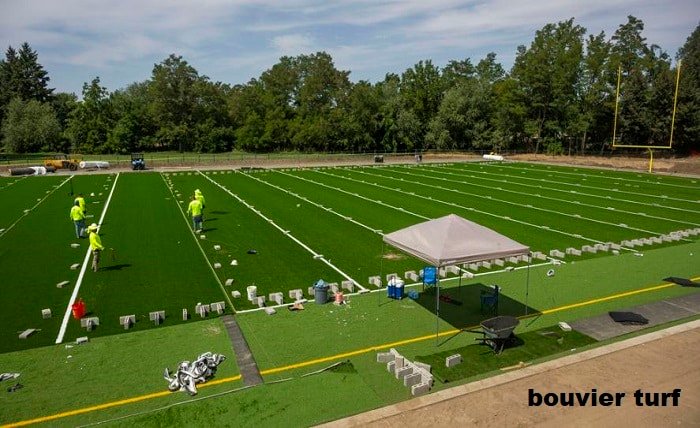The Ultimate Guide to Bouvier Turf: Everything You Need to Know

Introduction
When it comes to creating a perfect lawn, one of the best choices available to homeowners and landscapers alike is Bouvier turf. Known for its resilience and beauty, Bouvier turf has gained popularity due to its unique characteristics that make it ideal for various climates and uses. In this blog post, we will explore everything you need to know about Bouvier turf, including its features, benefits, and how to care for it.
What is Bouvier Turf?
Bouvier turf is a type of grass that has gained attention for its exceptional durability and aesthetic appeal. It’s a hybrid variety, often referred to as a cool-season grass, and is designed to thrive in temperate regions with moderate to cool climates. Bouvier turf features a lush, dense growth pattern that makes it a perfect choice for high-traffic areas such as lawns, sports fields, and golf courses. Its deep green color and strong root system help it to withstand various weather conditions, ensuring that your lawn remains vibrant throughout the year.
The grass type is particularly well-suited for places where lawns experience a lot of wear and tear, as it is resistant to diseases, pests, and drought. One of the key reasons why Bouvier turf is so popular is because of its ability to maintain its texture and appearance even when subjected to extreme conditions, which makes it a great long-term investment for homeowners.
Benefits of Installing Bouvier Turf
There are numerous benefits to installing Bouvier turf in your yard or landscape project. Firstly, Bouvier turf offers superior resilience. It can handle heavy foot traffic, making it ideal for families with kids or pets. Additionally, its ability to recover from damage quickly makes it an excellent choice for lawns that experience regular use.
Another major benefit of Bouvier turf is its low maintenance needs. Once established, it requires minimal care compared to other grass types, reducing the time and cost spent on lawn care. This is a significant advantage for homeowners who want a beautiful lawn without the constant upkeep. The thick, dense turf also helps to suppress weeds, further reducing the need for chemical treatments.
Moreover, Bouvier turf is environmentally friendly. It helps in preventing soil erosion due to its strong root system and can even improve air quality by trapping dust and pollutants. If you’re looking for a sustainable and low-maintenance grass option, Bouvier turf could be your ideal choice.
Different Types of Bouvier Turf
While Bouvier turf is typically known as a single species, there are variations in how it is cultivated and adapted to different environments. Some varieties of Bouvier turf are particularly suited for shady areas, while others are bred to withstand heat and drought. Understanding the different types of Bouvier turf can help you make an informed decision based on your specific lawn needs.
For example, some Bouvier turf varieties are designed to thrive in cooler climates, making them perfect for regions with long, cold winters. Others may be more tolerant of warmer climates and can handle higher temperatures with minimal irrigation. When selecting the right type of Bouvier turf, it’s important to consider your region’s climate and the amount of sunlight your lawn receives.
In addition to climate-specific varieties, Bouvier turf can also be adapted for different uses, such as ornamental lawns, sports fields, or even golf course greens. No matter the variety, all types of Bouvier turf share the same core characteristics: durability, low maintenance, and aesthetic appeal.
How to Lay and Install Bouvier Turf
Installing Bouvier turf is a relatively simple process, though there are several important steps to ensure successful establishment. The first step is to prepare the soil by removing any weeds, rocks, or debris. This will give the turf a clean, level base to root into. Additionally, it is essential to test the soil to determine if it needs any amendments such as fertilizer or lime.
Next, lay the Bouvier turf sod in a staggered pattern, ensuring that the edges of the sod pieces fit snugly together to prevent gaps. This will allow the roots to knit together more quickly, promoting faster establishment. After the turf is laid, water it thoroughly to encourage the roots to penetrate the soil. During the first few weeks, keep the soil consistently moist to help the turf establish itself.
Once established, Bouvier turf requires less frequent watering, as it is drought-tolerant. However, regular mowing and occasional fertilizing will help maintain its lush appearance and prevent the grass from becoming overgrown or unhealthy.
How to Care for Bouvier Turf
Maintaining Bouvier turf is relatively easy, especially when compared to other types of grass. To keep it looking its best, regular mowing is essential. It’s best to mow the grass when it reaches around 3-4 inches in height, cutting it to about 2.5-3 inches. Avoid cutting more than one-third of the grass height at a time, as this can stress the turf.
Watering is another important aspect of Bouvier turf care. While it is drought-resistant, it still requires adequate hydration during dry spells. In general, deep watering once or twice a week is preferable to frequent shallow watering. This encourages the roots to grow deeper and strengthens the grass.
Fertilizing your Bouvier turf is also recommended to maintain healthy growth. Applying a balanced fertilizer in the spring and fall will help to keep the turf lush and green. Be sure to follow the manufacturer’s instructions for proper application rates to avoid over-fertilizing, which can damage the grass.
Common Issues with Bouvier Turf and How to Solve Them
Though Bouvier turf is a hardy grass variety, it is not entirely immune to problems. One common issue is thatch buildup. Thatch is a layer of dead grass and roots that can accumulate on the surface of the soil, preventing water and nutrients from reaching the roots. If you notice that your Bouvier turf is thinning or struggling, it may be due to thatch buildup.
To combat thatch, consider aerating the soil once a year. This process involves creating small holes in the soil, allowing air, water, and nutrients to penetrate deeper into the root zone. Additionally, dethatching with a rake or machine can help reduce the thatch layer and improve turf health.
Another potential issue with Bouvier turf is the presence of pests such as grubs or chinch bugs. These insects can damage the root system, leading to patches of dead grass. If you notice such damage, it’s important to identify the pests and apply the appropriate treatment.
In general, though, Bouvier turf is highly resistant to common lawn diseases and pests, making it a low-maintenance option for homeowners.
Why Choose Bouvier Turf for Your Lawn?
There are many reasons why Bouvier turf should be at the top of your list when considering grass options for your lawn. It offers a perfect combination of durability, beauty, and low-maintenance requirements. Whether you’re dealing with heavy foot traffic, extreme weather conditions, or just want a beautiful lawn with minimal effort, Bouvier turf has you covered.
Its environmental benefits, including erosion control and air purification, make it a sustainable choice. Additionally, the wide variety of Bouvier turf options available means that there is likely a perfect fit for any climate or usage requirement. From family lawns to sports fields, Bouvier turf stands out as one of the best all-around turf options.
Conclusion
Bouvier turf is a superior choice for homeowners seeking a durable, aesthetically pleasing lawn that requires minimal maintenance. Whether you are dealing with high-traffic areas, drought conditions, or simply want a vibrant and lush lawn, Bouvier turf provides a reliable and resilient solution. With its resistance to pests, diseases, and extreme weather, this turf variety proves to be an excellent investment for long-term lawn care. By understanding the benefits, installation process, and care required for Bouvier turf, you can ensure your lawn stays beautiful and healthy for years to come.
FAQs
- What is Bouvier turf?
Bouvier turf is a hybrid grass variety known for its durability, lush appearance, and low-maintenance needs. It is ideal for lawns, sports fields, and other high-traffic areas. - How do I install Bouvier turf?
To install Bouvier turf, prepare the soil by removing debris, level the ground, and lay the sod in a staggered pattern. Water thoroughly and keep the soil moist during the initial establishment phase. - Is Bouvier turf drought-resistant?
Yes, Bouvier turf is drought-resistant and requires less water than many other grass varieties once established. However, it still needs deep watering during dry spells to stay healthy. - How often should I mow Bouvier turf?
Mow Bouvier turf when it reaches 3-4 inches in height, cutting it down to about 2.5-3 inches. Avoid cutting more than one-third of the grass height at once. - Can Bouvier turf handle heavy foot traffic?
Yes, Bouvier turf is known for its resilience to heavy foot traffic, making it perfect for areas with high activity, such as lawns with children or pets.




